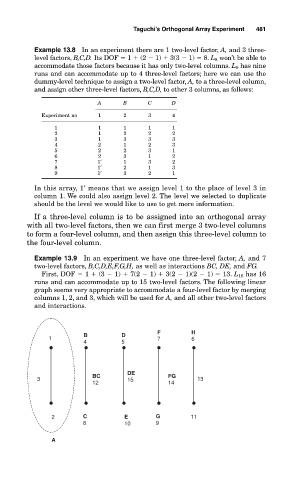Page 522 - Design for Six Sigma a Roadmap for Product Development
P. 522
Taguchi’s Orthogonal Array Experiment 481
Example 13.8 In an experiment there are 1 two-level factor, A, and 3 three-
level factors, B,C,D. Its DOF 1 (2 1) 3(3 1) 8. L 8 won’t be able to
accommodate those factors because it has only two-level columns. L 9 has nine
runs and can accommodate up to 4 three-level factors; here we can use the
dummy-level technique to assign a two-level factor, A, to a three-level column,
and assign other three-level factors, B,C,D, to other 3 columns, as follows:
A B C D
Experiment no 1 2 3 4
1 1 1 1 1
2 1 2 2 2
3 1 3 3 3
4 2 1 2 3
5 2 2 3 1
6 2 3 1 2
7 1′ 1 3 2
8 1′ 2 1 3
9 1′ 3 2 1
In this array, 1′ means that we assign level 1 to the place of level 3 in
column 1. We could also assign level 2. The level we selected to duplicate
should be the level we would like to use to get more information.
If a three-level column is to be assigned into an orthogonal array
with all two-level factors, then we can first merge 3 two-level columns
to form a four-level column, and then assign this three-level column to
the four-level column.
Example 13.9 In an experiment we have one three-level factor, A, and 7
two-level factors, B,C,D,E,F,G,H, as well as interactions BC, DE, and FG.
First, DOF 1 (3 1) 7(2 1) 3(2 1)(2 1) 13. L 16 has 16
runs and can accommodate up to 15 two-level factors. The following linear
graph seems very appropriate to accommodate a four-level factor by merging
columns 1, 2, and 3, which will be used for A, and all other two-level factors
and interactions.
F H
B D
1 7 6
4 5
DE
BC FG
3 15 13
12 14
2 C E G 11
8 10 9
A

